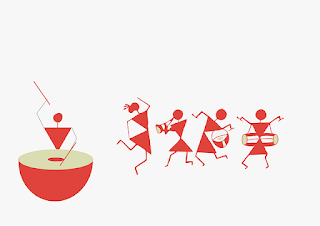One of the classic tribal art forms that originated in India is the Warli painting, which is immensely popular today on buildings, wall murals, sarees, shawls, and even coffee mugs. The term 'Warli' comes from the largest tribe situated on the outskirts of Maharashtra's metropolis, Mumbai. It was previously painted by indigenous people from India's North Sahyadri Range. Cities in this range include Dahanu, Talasari, Jawhar, Palghar, Mokhada, and Vikramgadh in the Palghar district.
The tribal style of art is believed to have originated in the 10th century A.D. Warli art is usually done by tribal people to paint their clay houses. Warli art is well recognised for its one-of-a-kind renderings of natural elements. Because the Warli culture worships mother nature, rituals centred on the idea of nature worship are frequently shown in these paintings. In Warli paintings, there are typically intricate geometric patterns of flowers, wedding rites, hunting scenes, and other everyday activities.
Tarpa dance is a key theme in all Warli paintings. Both men and women join their hands and gather together around the Tarpa players. In their paintings, Warli painters depict unity and their ancient tradition. Those from Gujarat and Maharashtra can be found on the walls, which are adorned with white designs against red ochre bricks. Jivya Mashe is a well-known Warli artist. In recognition of his services, he received the Padma Shri Award in 2011.

image mariananbu/ Pixabay
Warli paintings are frequently associated with traditional Warli folklore. The tribesmen demonstrate their belief in heritage through their warli art. Numerous animals from their environment are featured in these Warli paintings. Tiger is a well-known animal painting in Warli art. In these paintings, a flock of birds is frequently grouped symmetrically.
The Warli paintings illustrating customs and ceremonies are the most prominent of all the types. This category depicts joy, happiness, celebration, and day-to-day activities. Human beings in the form of stick figures perform rituals, play musical instruments, dance, and so on. Originally, the paintings were done on walls, but throughout time, warli art was drawn on a variety of other materials such as bamboo, garments, pots, and so on. These prints are now even used by major fashion houses.
Originally painted with white rice paste on Earth-brown, the backdrop colours of Warli art have evolved to include Henna, Indigo, Ochre, Black, Earthy mud, and Brick red. The tribesmen's various Warli art forms portray the basic existence they lived. It is commonly assumed from Warli art that the tribes believed in the time cycle, as portrayed in their spherical paintings. The Warli paintings depict rural life as well. Warli art also suggests that Warli tribes believe in joy, dance, and festivities, as evidenced by the paintings of Warli dancers.
These paintings are far from realism and do not have intricate detailed human figures. Its minimalism is what makes it unique and appealing to the eyes. Its simplicity of depiction and portrayal of a basic lifestyle in harmony with nature and the tribe's traditional customs. In today's modern and busy world, Warli paintings act as a reminder of the beauty in simplicity. As a result, this simple artform continues to soothe the eyes of not only Indians, but also art fans from all over the world.
